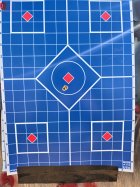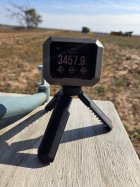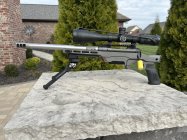There is nothing wrong with throwing a heavy bullet like the Berger 55 at slower speeds.
When you push them with 223/556 cases or 204 Ruger cases, you will just be slower than the same cases pushing the Seirra 39 or Hornady 40.
If someone wants to run the 55 out of a 223/556 or 204 Ruger variant, then they should go for it cause life can be short and if it makes them happy, why not.
If for a moment, we say that a typical 204 Ruger will produce roughly 1300 ft*lbs pushing a 40 gr, and we estimate the speed of the 55 grain at that energy, we would get roughly 3260 fps.
I have seen folks get their 55s up to just under that 3260 fps estimate in their 20P and 204 R cases.
If we check the trajectory of the 55 grain at 3260 fps, and compare it to the 40 grain at 3850, it tells a story.
If you try to look at where the 55 grain will show a significant advantage in terms of downrange trajectory, it takes roughly 3600 fps or more to make it shine. That is roughly 1583 ft*lbs in terms of the energy required from the cartridge, or in other words well above any 223 or 204 Ruger case at normal pressure.
For perspective, a 6 Dahser pushing a 105 at 2850 fps produces roughly 1893 ft*lbs.
A 22-250 pushing a 40 gr at 4224 fps is producing 1585 ft*lbs, same 22-250 using 55 gr at 3786 fps is producing 1751 ft*lbs.
We already mentioned, not everyone cares if their heavier bullets have a "better" trajectory and there is no law that says you cannot throw heavy bullets slower and still be happy.
A user still has to consider the appropriate twist needed for a 55 grain versus a 39 or 40 grain and what that means when/if used with the lighter bullets.
Here is a comparison of the typical energy levels with the 20 cal 40 VMax compared to a 55 Berger at 600 and 400 yards.
G7 BC Berger 55 Varmint BT = 0.182
G7 BC Honrady 40 VMax = 0.116


















